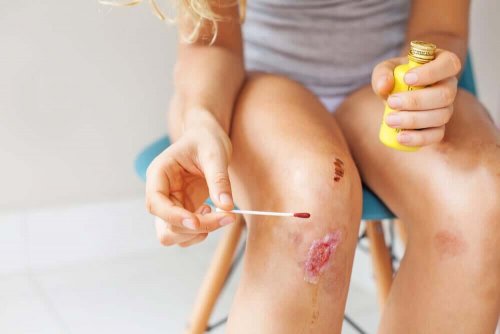How to Treat an Infected Wound

At some point in our lives, we all suffer from an infected wound. By not giving it the right attention and cleaning it properly, bacteria can prevent the wound from healing, and at the same time you increase the risk of scarring and other complications.
Even though an infected wound is common, we still have to be very careful. This depends on the bacteria that infects the wound, which could be life-threatening to the patient. For example, bacteria that causes tetanus can create serious medical complications for the patient.
Today we’ll learn how to treat an infected wound by following these simple yet essential steps. This will allow the wound to heal and prevent it from getting worse. Let’s see what they are.
Steps for treating an infected wound
Treating an infected wound is easy, all you have to do is follow some simple steps that will stop bacteria from manifesting. People with a weak immune system need to take extra precautions.
Specifically patients with immunosuppressive, infectious, or diabetic diseases. This is because they are more likely to get an infected wound. Therefore, they need to follow the steps below as soon as possible.
Cleaning the wound

In order to treat the infected wound, you need to clean it first. The best way to do this is by using soap and water. Depending on the type of wound, always take care not to damage it further.
If the wound isn’t serious we can use cotton wool to help clean it, as it won’t get stuck in the wound. Otherwise, it’s better to use gauze.
Try not to scratch the wound with the gauze or cotton wool. The best way to use these materials, is to gently pat them over the wound.
You may find this interesting: Three Natural Soaps You Can Make at Home
Proper treatment

Even though you have cleaned the wound with soap and water, it isn’t enough. To treat an infected wound, it’s important to select the proper treatment. A professional at a local pharmacy or medical center will help you decide what solution is best for you. However, below are some treatments that can be applied:
- Antibiotic ointment: acts against bacteria that infect the skin. Always clean the wound with soap and water before applying it. This treatment is specifically for dry wounds.
- Antiseptics: using antiseptics such as Betadine® (povidone-iodine) or chlorhexidine will eradicate the infection and the wound will heal much faster. Please bear in mind that bodily fluids will counteract povidone. The best option for a recent, open wound would be to use chlorhexidine.
- Bandages: Bandages help protect the wound and keep the infection from coming back. However, if it sticks to the wound, it’s better to allow it to breathe. Of course, at the same time keeping on top of the care mentioned above.
We must always wash our hands before treating a wound, whether we are using cotton wool or not. By doing this, we are stopping bacteria from making contact.
You may find this interesting: What You Should and Shouldn’t Do when Treating a Wound
Antibiotics
If the infection in the wound is serious, you need to see a doctor. We’ll know this if there’s a yellow discharge, if the wound has changed color, if there’s swelling or pain increases, and if fever appears. The doctor is more than likely to prescribe oral antibiotics to help fight the bacteria more effectively. Despite this, continue following the steps above.
Preventing infections
The best way to avoid having to deal with an infected would is to prevent it from becoming infected in the first place. To do this, we need to clean it as soon as possible to get rid of any dust, dirt or anything that could risk infection.
After this, allow it to breathe for about 24 hours and cover with gauze to help protect it. Treating it with hydrogen peroxide and Betadine® is a very effective way of speeding up the healing process. If we follow these recommendations, we can prevent any wound from becoming infected.
Do you frequently get infections from wounds? If so, we recommend that you put the advice mentioned above into practice as well as going to get a blood test to check the strength of your immune system.
All cited sources were thoroughly reviewed by our team to ensure their quality, reliability, currency, and validity. The bibliography of this article was considered reliable and of academic or scientific accuracy.
- Salem Z., C., Pérez P., J. A., Henning L., E., Uherek P., F., Schultz O., C., Butte B., J. M., & González F., P. (2000). Heridas: Conceptos generales. Cuadernos de Cirugía. https://doi.org/10.4206/cuad.cir.2000.v14n1-15
- Ruiz, E. F. (2013). Antisépticos y desinfectantes. Enfermedades Infecciosas y Microbiologia. https://doi.org/10.1007/s00299-010-0857-1
- Sánchez, L., & Anduaga, E. (2005). Anticepticos y Desinfectantes. Dermatología Peruana Antisépticos y Desinfectantes Dermatología Peruana.
- Luna, C., Vázquez, P., Javier, F., Prieto, P., Ruiz, B., Saura, P., (n.d.). CLORHEXIDINA VS. POVIDONA IODADA como antiséptico de la piel. Retrieved from http://vapox.com/sitefiles/noticiasdocs/50/arDocumento_28_2_1.pdf
- Martínez-Gómez, D. de A. (2004). Tratamiento de la infección en el pie diabético. Cirugía Española, 76(1), 9–15. https://doi.org/10.1016/S0009-739X(04)72347-7
This text is provided for informational purposes only and does not replace consultation with a professional. If in doubt, consult your specialist.








